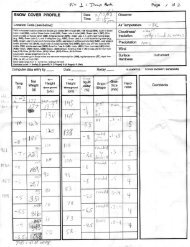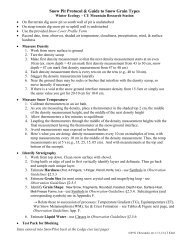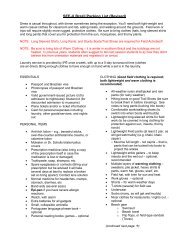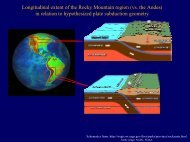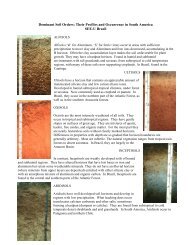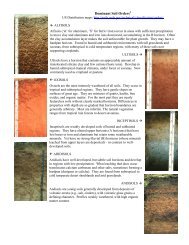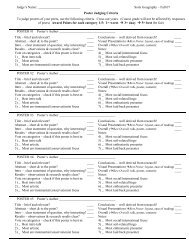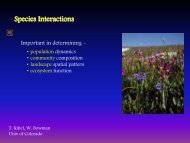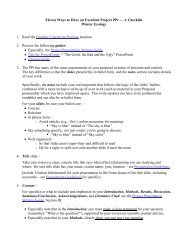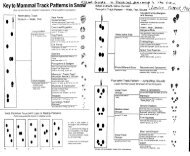Write-up for Field Trip 1
Write-up for Field Trip 1
Write-up for Field Trip 1
Create successful ePaper yourself
Turn your PDF publications into a flip-book with our unique Google optimized e-Paper software.
Instructions — <strong>Write</strong>-<strong>up</strong> <strong>for</strong> <strong>Field</strong> <strong>Trip</strong> 1: PedosequenceUNLV BiogeographyQuestion to be addressed:What is the toposequence of soils in a southern Nevada Basin and Range system?You may share in<strong>for</strong>mation from your field notes, but your report must be your own work.Due Monday beginning of class. Please include your name in the filename, and submit by email to Instructorand TA (kittel@colorado.edu, adam.leland@gmail.com)I. Task is to describe and explain the <strong>for</strong>mation of soils at 3 sites along our toposequence:1. For the first site, choose one of the first 2 sites we visited in El Dorado valley (our site #1, 2; on Doug’shandout: sites 2, 6)2. The 2 nd point – the alluvial fan where we dugout a road cut, on the road Christmas Tree Pass (our site #3)3. The 3 rd point – at the top of Christmas Tree Pass, both N&S-facing soils (our site #4)II. Overall structure: Use the “double-funnel” model <strong>for</strong> presenting material:1. Introduction – The overall context of what you’re writing about: What’s the paper’s purpose andtopic’s importance.2. Body of paper – site-by-site descriptions (see Section III)3. Discussion – integrating the 3 sites, giving a landscape perspective4. Conclusions – summary = your take-home messagesNotes: Be sure to cite sources Provide captions <strong>for</strong> figures (e.g., images or sketches) used to illustrate your points. Be sure to creditphotos. Length guidelines: ~3 pages, not including images, references. (Length guideline based on12 pt, TimesRoman, double-spaced.)III. Site description <strong>for</strong> each should include –(1) Description of the soil(2) Soil’s development processes: An explanation of how that soil developed, and how that developmentdepended on topographic position – that is, along our toposequenceSpecifically, be sure to cover:1. General site description – accompanied by a very general diagram or labeled photo Geomorphic surface – description of site’s landscape position, especially in context of ourother sites. Vegetation – general description of vegetation (dominants)2. What soil order the site’s soil belongs to – define or explain why it’s this order.3. Soil profile – description of major layers based on Doug’s discussion and Soil series Use your own words!o Base this on your own visualization from Doug’s descriptions, the Series descriptions,and, especially in the case of where we dug a pit, on your own observations.o However, don’t reiterate the NRCS soil series descriptions (=plagiarism).
Define any special terms – guideline: if you or your classmates likely didn’t know a termbe<strong>for</strong>e taking this class, explain it. For our pit – Accompany your discussion with a diagram or labeled photo of pit4. Tell a story of how that soil came to be <strong>for</strong> each site in the toposequence Explain the <strong>for</strong>mation of layers in the profile description. Note the role of topography and the other functional factors (Doug’s “dials”) as appropriate(climate, parent material, organisms, time).2Resources:o Doug’s <strong>Field</strong>trip guides: Laughlin, Grapevineo Soil Series descriptions <strong>for</strong> sites (pdf)o GoogleEarth (.kmz files) Waypoints with photos SoilWebo Doug’s photos –https://plus.google.com/photos/103063479216476848414/albums/5715198030208978721?authkey=CPTp2bPm69OGKgo SoilWeb interfaces: http://casoilresource.lawr.ucdavis.edu/dr<strong>up</strong>al/node/902T. Kittel 310, r312



